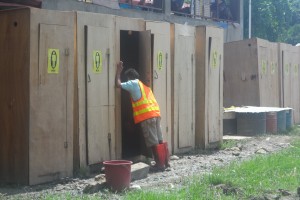Zamboanga City — Sta. Maria Elementary School is still considered home by 391 families who were displaced by the clash between government troops and the Moro National Liberation Front-Misuari faction. These families fled their homes immediately after the armed conflict broke-out on September 9.
Camp Manager Minda Ramos, City Social Welfare and Development Officer recounted how things were not easy at the start.

“We had to constantly remind the families to organize themselves and clean their area, especially that classes have resumed. We do not want the schoolchildren to be infected with communicable diseases caused by unsanitary surroundings,” she added.
In doing their part, the male evacuees organized themselves and volunteered their services in ensuring the safety of the evacuees and in keeping the center clean.
According to Juan Villaceron Escola, 57, from Brgy. Talon-Talon, “organisado ang mga kalalakihan dito. Sinasabi naming kailangan may unity kami. Mapa-Kristiyano o mapa-Muslim, pantay-pantay, dapat tulong-tulong. Meron kaming assigned sa security at meron sa paglilinis. Nagpapalitan kami sa gawain. (The male evacuees are organized. We tell one another that we must be united, whether Christians or Muslims. We are all equal here, thus, we need to help one another. We have assigned people to look after the security and cleanliness of surroundings. We take turns in doing the work.)”
Twenty-eight year old James Daprosa added, “lahat kami nagbo-volunteer. Naglilinis din kami dito sa paligid, pati sa banyo. (All of us volunteer our services. We clean the evacuation center, as well as the toilets.)”
The volunteers also helped construct the community kitchen which was provided by the Zamboanga Evangelical Disaster Response Network. The group also committed to provide utensils.

Manuel Labao, 40, said they appreciate the newly constructed community kitchen.
“Pwede magluto kung sino ang may gusto. Malaki naman yung kitchen. Welcome sa amin at nagpapasalamat kami sa pagkain na binibigay sa amin. Pero mas okay itong naluluto namin yung gusto naming kainin. (Anyone may cook here as the kitchen is big. We are thankful of the cooked food we are provided but cooking our own food is better.),” Labao added.
Also, the Social Protection Cluster established a referral system at the evacuation center to ensure that evacuees, especially the women and children, are protected from abuse. Tarpaulins, provided by the International Organization for Migration (IOM), indicating the referral system with hotline numbers are posted in conspicuous areas at the evacuation center.
Further, the Department of Social Welfare and Development (DSWD) Field Office IX together with the Community and Family Services International (CSFI) recently conducted a training among camp managers on handling cases of gender-based violence inside evacuation centers.
Although the evacuation center at the Sta. Maria Elementary School is managed by the city government, the DSWD FO IX continues to provide assistance there. A DSWD staff is assigned to help Ramos manage it. Further, DSWD FO IX continues to provide relief packs to the evacuees.
Ramos added that they try to inject normalcy inside the center. They plan to hold a simple activity in observance of the Children’s Month Celebration. Other activities like singing and dancing contests, and recreational activities are being done for the evacuees.
She added that a mass was held for the evacuees on October 16 at the Sta. Maria Parish Church. Fr. Moi Cuevas officiated the mass, with the parish also providing dinner for all evacuees.
Ramos is happy that around 100 families in the evacuation center have returned to their respective homes in Brgy. Talon-Talon and nearby barangays. These families were provided by DSWD with ‘pabaon’ relief packs composed of rice, canned goods, noodles and coffee good for one week. ###


